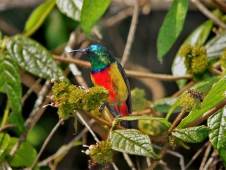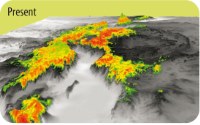
Climate-envelope modeling at high resolution in the Albertine Rift Valley of East Africa has allowed finer-scale projections of climate change impacts on birds than previously available. The results for 14 bird species endemic to the rift are alarming: suitable climatic conditions for all species are projected to move upslope over the coming decades, by, on average, 350 m by 2085. Some areas are projected to support none of the species by the end of the century, and at least one species Red-collared Mountain-babbler Kupeornis rufocinctus is projected to lose all suitable climate within the region.

Understanding the likely impacts of climate change on species of conservation concern is necessary to facilitate climate change adaptation. Climate-envelope modeling is a widely used approach, involving modeling the current distribution of species in relation to climatic variables, and then applying these models to climate projections. BirdLife International Partners, Durham University, the Wildlife Conservation Society, Makerere University, and the Albertine Rift Conservation Network have recently collaborated to apply this approach in the Albertine Rift Valley of East Africa. Modeling at 30 arc-second resolution (c.1 km2) has allowed finer-scale projections than previously available. The results for 14 bird species endemic to the rift are alarming: suitable climatic conditions for all species are projected to move upslope over the coming decades, by, on average, 350 m by 2085. Some areas are projected to support none of the species by the end of the century, and at least one species Red-collared Mountain-babbler Kupeornis rufocinctus is projected to lose all suitable climate within the region. However, some regions outside the current IBA network are projected to be crucial in providing suitable environmental conditions for many of the 14 species by 2085. As such, protection and or restoration (as appropriate) of the forests in these regions is likely to represent a key adaptive management strategy in an effort to ensure the resilience of the Albertine Rift’s IBA network under climate change.
This case study is taken from ‘The Messengers: What birds tell us about threats from climate change and solutions for nature and people’. To download the report in full click here.
Related Species
Links
Compiled: 2013 Copyright: 2013
Recommended Citation:
BirdLife International (2013)
Climate change modelling highlights the vulnerability of birds in the Albertine Rift Valley.
Downloaded from https://datazone.birdlife.org/climate-change-modelling-highlights-the-vulnerability-of-birds-in-the-albertine-rift-valley on 22/12/2024